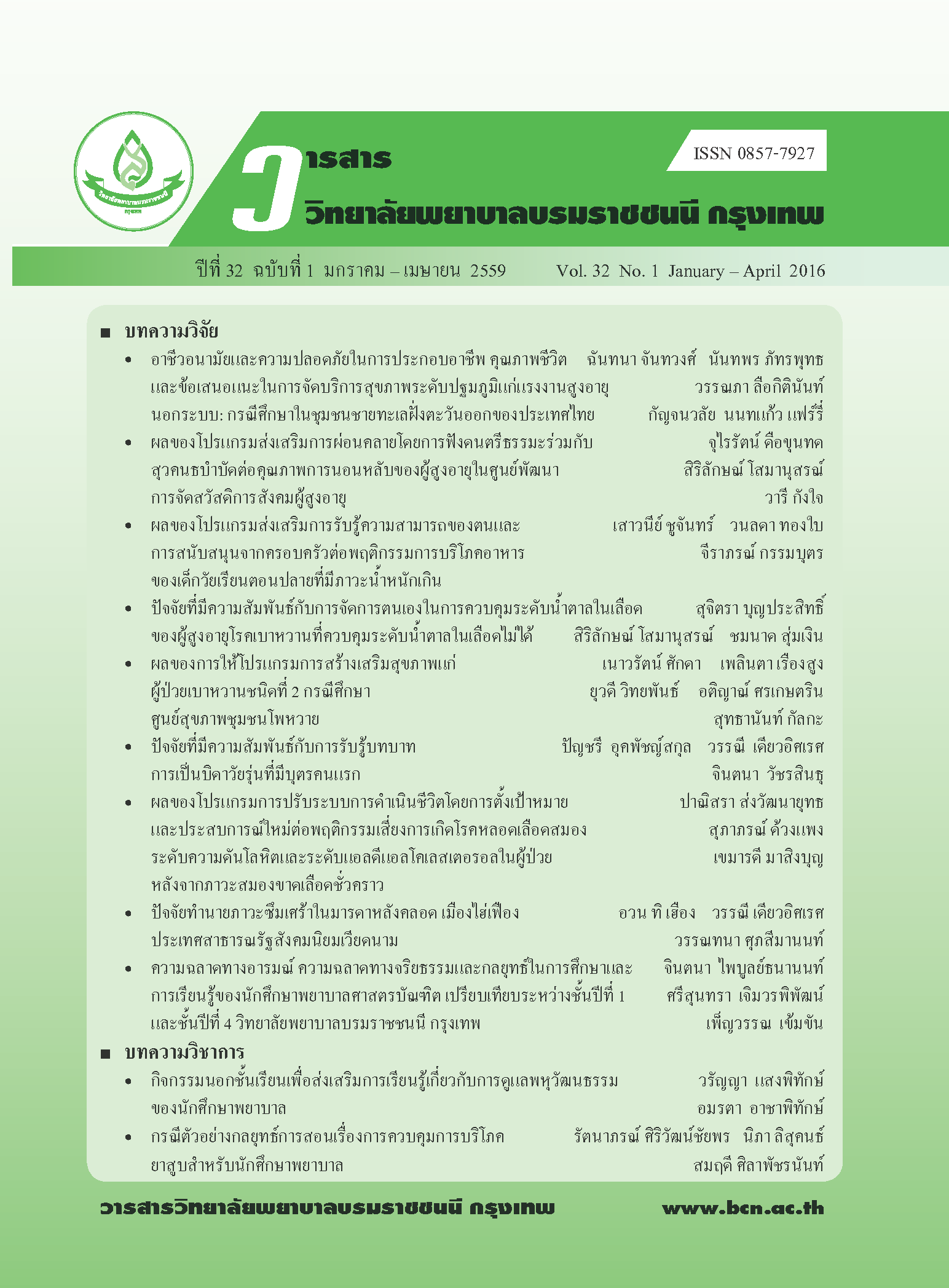ปัจจัยทำนายภาวะซึมเศร้าในมารดาหลังคลอด เมืองไฮ่เฟือง ประเทศสาธารณรัฐสังคมนิยมเวียดนาม FACTORS PREDICTING POSTPARTUM DEPRESSION AMONG WOMEN IN HAI PHONG CITY, VIETNAM
คำสำคัญ:
ภาวะซึมเศร้าหลังคลอด, มารดาหลังคลอด, เวียดนาม, postpartum depression, postpartum mothers, Vietnamบทคัดย่อ
บทคัดย่อ
การวิจัยครั้งนี้มีวัตถุประสงค์เพื่อศึกษาอัตราความชุกและปัจจัยทำนายภาวะซึมเศร้าหลังคลอดในมารดา
ทีอาศัยในเขตชุมชนเมือง กลุ่มตัวอย่างเป็นในมารดาในระยะ 4 ถึง 12 สัปดาห์หลังคลอด ที่มารับบริการตรวจ
สุขภาพหรือพาบุตรมารับวัคซีนที่ศูนย์บริการสุขภาพชุมชนในเขตอำเภอโหงว เกวียง เมืองไฮ่เฟือง จำนวน
108 คน เก็บข้อมูลโดยใช้แบบสอบถามจำนวน 6 ชุด วิเคราะห์ข้อมูลโดยสถิติพรรณนาและการวิเคราะห์
ถดถอยพหุคูณ ผลการศึกษาพบความชุกของภาวะซึมเศร้าหลังคลอดร้อยละ 21.3 (คะแนนแบบวัด Edinburgh
Postnatal Depression Scale: EPDS ≥ 13) ปัจจัยคัดสรรทุกปัจจัยซึ่งประกอบด้วย ความเครียดจากการเลี้ยง
บุตร แรงสนับสนุนทางสังคม ความพึงพอใจในชีวิตสมรส และความรูสึกมีคุณค่าในตนเอง สามารถร่วมกัน
อธิบายความผันแปรของภาวะซึมเศร้าหลังคลอดได้ร้อยละ 55.6 โดยความเครียดในการเลี้ยงดูทารกเป็น
ปัจจัยที่มีอิทธิพลสำคัญที่สุด (β -.36, p < .001) ผลการศึกษาชี้ให้เห็นว่ามารดาหลังคลอดในเวียดนามมี
ภาวะซึมเศร้าในอัตราที่สูง ดังนั้นพยาบาลควรมีการติดตามประเมินภาวะซึมเศร้าในมารดา หลังคลอดและ
ให้การพยาบาลเพื่อการป้องกัน โดยเน้นแก้ไขปัจจัยที่มีอิทธิพลดังกล่าว
Abstract
This study aimed to determine prevalence and factors that may predict postpartum depression among postpartum mothers in an urban district of Vietnam. One hundred and eight mothers between 4 to 12 weeks postpartum were randomly selected from four communal health centers in the Ngo Quyen district, Hai Phong, Vietnam. Six self-report questionnaires were used to collect data. The data was analyzed using descriptive statistics and standard multiple regressions. The results of the study revealed that prevalence of probable depression was 21.3% (EPDS ≥ 13). Multiple regression analysis showed that 55.6% of the variance in postpartum depression was explained by childcare stress, social support, marital satisfaction, and self-esteem. The strongest predictor of postpartum depression was child care stress (β = -.36, p < .001). It is concluded that prevalence of postpartum depression in Vietnam is high. Nursing interventions need to be developed by focusing on early detecting postpartum depression and manipulating predicting factors, such as decreasing childcare stress, promoting social support, marital satisfaction, and self-esteem.
Downloads
ดาวน์โหลด
เผยแพร่แล้ว
รูปแบบการอ้างอิง
ฉบับ
ประเภทบทความ
สัญญาอนุญาต
บทความที่ได้รับการตีพิมพ์ เป็นลิขสิทธิ์ของวารสารวิจัยสุขภาพและการพยาบาล (วิทยาลัยพยาบาลบรมราชชนนี กรุงเทพ) ไม่สามารถนำไปตีพิมพ์ซ้ำในวารสารฉบับอื่น


















